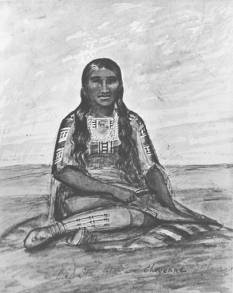Great Woman: Owl Woman of the Cheyenne, d 1847
As Natives mingled with traders and other early adventurers on the frontier, it was inevitable that their cultures would mingle through relationships. Whether those relationships were based on love or need depended on the two people involved. However, William Bent's relationship with Owl Woman seems to have been a power partnership based on two equal people bringing the best of both their cultures to their family and circumstances.
Owl Woman, Mis-stan-stuf, was the daughter of White Thunder, a powerful Cheyenne war leader and medicine man. Contrary to popular lore, this didn't make her a princess. Most Native tribes in North American did not have royalty or aristocracy. Being born into a certain clan or family might give someone status, but it wasn't always hereditary. Men and women had to prove their rights to leadership. White Thunder was the custodian of the Four Arrows, a sacred talisman in Cheyenne Society. The arrows had been lost through conflict with the Pawnee and it was his responsibility to work for their return. In 1833, he was able to negotiate the return of two of the arrows. On his way back from the parley, he met William Bent, who along with his brothers and Ceran St. Vrain, were looking to start a trading post along the Santa Fe Trail. Around the time that the two men met, a meteor shower convinced White Thunder that his meeting with Bent was a good idea. The two became friends.
William and his brother Charles were rapidly accepted into Cheyenne society. White Thunder called William, Little White Man and soon realized that a trading alliance with someone who took the time to learn the language and understand their culture was an investment for them both. Whether William Bent had by this time caught the eye of the chief's pretty eldest daughter, or whether her father suggested the match, they were married in a traditional Cheyenne ceremony. Owl Woman set up her lodge near Bent's Fort, and also sepnt time living with him at the Fort. He also lived with her and from time to time went with the Cheyenne on hunting trips which expanded his abilities for trade. The couple had four children, Mary/Hoka, Robert/Octavi-weehis, George/Ho-My-Ike and Julia/Uh-ma. The children learned several languages and functioned in both their parents' cultures.
While Bent was away visiting other tribes or on hunting trips, Owl Woman kept track of the Fort store and supervised the servants. Her presence at the Fort may have served as a deterrent to attack by other tribes. A man with a woman and family was not a threat. In time, Owl Woman's two sisters, Yellow Woman and Island, also became Bent's wives. Then, tragedy struck. In 1847 a cholera plague swept through the Cheyenne population, claiming Owl Woman among its victims. Bent abandoned his fort and its memories, and the fort burned down in a suspicious fire two years later. Yellow Woman raised Owl Woman's children as her own. Though she and Bent later went their separate ways, they remained cordial.
Owl Woman was named to the Colorado Women's Hall of Fame in 1985.
Owl Woman, Mis-stan-stuf, was the daughter of White Thunder, a powerful Cheyenne war leader and medicine man. Contrary to popular lore, this didn't make her a princess. Most Native tribes in North American did not have royalty or aristocracy. Being born into a certain clan or family might give someone status, but it wasn't always hereditary. Men and women had to prove their rights to leadership. White Thunder was the custodian of the Four Arrows, a sacred talisman in Cheyenne Society. The arrows had been lost through conflict with the Pawnee and it was his responsibility to work for their return. In 1833, he was able to negotiate the return of two of the arrows. On his way back from the parley, he met William Bent, who along with his brothers and Ceran St. Vrain, were looking to start a trading post along the Santa Fe Trail. Around the time that the two men met, a meteor shower convinced White Thunder that his meeting with Bent was a good idea. The two became friends.
William and his brother Charles were rapidly accepted into Cheyenne society. White Thunder called William, Little White Man and soon realized that a trading alliance with someone who took the time to learn the language and understand their culture was an investment for them both. Whether William Bent had by this time caught the eye of the chief's pretty eldest daughter, or whether her father suggested the match, they were married in a traditional Cheyenne ceremony. Owl Woman set up her lodge near Bent's Fort, and also sepnt time living with him at the Fort. He also lived with her and from time to time went with the Cheyenne on hunting trips which expanded his abilities for trade. The couple had four children, Mary/Hoka, Robert/Octavi-weehis, George/Ho-My-Ike and Julia/Uh-ma. The children learned several languages and functioned in both their parents' cultures.
While Bent was away visiting other tribes or on hunting trips, Owl Woman kept track of the Fort store and supervised the servants. Her presence at the Fort may have served as a deterrent to attack by other tribes. A man with a woman and family was not a threat. In time, Owl Woman's two sisters, Yellow Woman and Island, also became Bent's wives. Then, tragedy struck. In 1847 a cholera plague swept through the Cheyenne population, claiming Owl Woman among its victims. Bent abandoned his fort and its memories, and the fort burned down in a suspicious fire two years later. Yellow Woman raised Owl Woman's children as her own. Though she and Bent later went their separate ways, they remained cordial.
Owl Woman was named to the Colorado Women's Hall of Fame in 1985.




Comments
Post a Comment